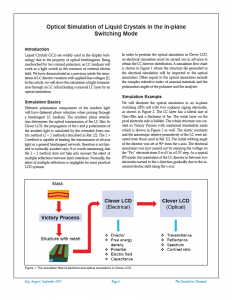Optical Simulation of Liquid Crystals in the In-plane Switching Mode
Introduction
Liquid Crystals (LCs) are widely used in the display technology due to the property of optical birefringence. Being sandwiched by two crossed polarizers, an LC medium will work as a light switch in the existence of external electric field. We have demonstrated in a previous article the simulation of LC director variation with applied bias voltages [1]. In this article, we will show the calculation of light transmission through an LC cell including a uniaxial LC layer by an optical simulation.
Simulation Basics
Different polarization components of the incident light will have different phase velocities when passing through a birefringent LC medium. The resultant phase retardation determines the optical transmission of the LC film. In Clever LCD, the propagation of the s and p polarization of the incident light is calculated by the extended Jones matrix method (2 × 2 methods) described in Ref. [2]. The 2 × 2 method is capable of treating the transmission of off-axis light in a general birefringent network, therefore is not limited to normally incident rays. It is worth mentioning that the 2 × 2 method does not take into account the effect of multiple reflections between layer interfaces. Normally, the effect of multiple reflections is negligible for most practical LCD systems.



